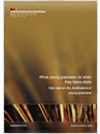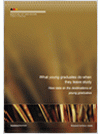This report focuses on the destinations of young domestic graduates. It complements our recent publication 'What young graduates earn when they leave study' which looks at the earnings of young graduates who remain in New Zealand. In this report, we focus on differences in what graduates do rather than what they earn after they complete their studies. We look not only at those who remain in New Zealand but also those who go overseas.
We also investigate whether trends in what graduates do after they complete their studies have changed in the last eight years or not (looking in detail at cohorts who graduated in 2003 to 2010). Comparing current figures to these historical ones finds that overseas rates have changed little over the past eight years, but employment, benefit and further study rates have changed, particularly during the recent global financial crisis.
Purpose
Knowing what graduates do after they complete their studies is important as it lets us know what types of graduates go overseas and how long for, while also looking at who does further study, enters employment or has a spell on a benefit. This sort of analysis is fundamental to an assessment of how the tertiary education system serves New Zealand. This is important as the Government makes a very large investment in tertiary education each year – funding tertiary education providers, providing subsidised student loans and granting student allowances. This information will also help prospective students, their families and advisors determine whether a particular course of study is likely to get them the result that they want. Individuals make a considerable financial and time investment when they choose to study a qualification, and this information will help them to make wise decisions.
Key Results
- Graduates who complete qualifications at different levels differ in what they do post study. Young, domestic graduates who complete qualifications below degree level are more likely to do further study after they complete their qualification, with around half of level 1-4 certificate and level 5-7 diploma graduates continuing on to do further study. Those who complete qualifications at higher qualification levels are more likely to be employed in the first year post study, with around half of all bachelors and honours graduates employed, and 55% of masters and doctorate graduates.
- Graduates who complete qualifications at different levels show different employment rate trends over time. Employment rates increase over each of the first seven years after study for young domestic graduates who complete a level 1-4 certificate or level 5-7 diploma. Many of these graduates do additional study after their first qualification so increasing their skill level and enhancing their prospects of employment. In contrast, employment rates tend to decline over time for young domestic graduates who do a bachelors qualification or higher as the percentage of graduates who go overseas increases with time. However, despite employment rates moderating over time, it is important to note that the earnings premium that those who complete higher qualifications enjoy remains consistent over time.
- Very few young people who complete a qualification at diploma level or above are on a benefit in the first seven years after study. Around 5 percent of level 5-7 diploma graduates are on a benefit and around 1 percent of bachelors graduates, in each of the first seven years after study. But it is around 12 percent for those who graduated with certificates at levels 1-3.
- Current overseas rates are comparable to historic ones. There has been no increase in the rate of departure of young New Zealanders at most qualification levels. There are also indications that the percentage of young domestic graduates who go overseas may be decreasing in more recent cohorts for those who have studied graduate certificates or honours level qualifications. However rates have increased for masters graduates in the first two years post study.
- The proportion of young graduates who go overseas generally increases with the level of qualification gained. In the first year after study, 3 percent of certificate level graduates go overseas, 5 percent of diploma graduates and around 10 to 11 percent of bachelors and honours graduates. There is then a jump with 20 percent of masters and 30 percent of doctorate young domestic graduates going overseas in their first year post study.
- The percentage of graduates who go overseas increases with time and the rate of increase generally increases with qualification level. Seven years after study, 17 percent of certificate 1-3 graduates are overseas, 21 percent of diploma graduates, 31 percent of bachelors graduates and 41 percent of doctorate graduates.
- The percentage of young graduates who go overseas appears to flatten off and reach a maximum around six to seven years after graduation. This is particularly the case for those who have studied at higher qualification levels. The exception is doctorate students which reach a peak around three to four years after study. Given the high initial number of doctorate graduates who go overseas, the early flattening of the overseas proportion is most likely due to a large number of doctorate graduates going overseas immediately after their studies in order to complete a postdoctoral placement, with some then returning.
- Graduates outcomes were affected by the recent global financial crisis, with different trends seen for graduates at different qualification levels. Employment rates dropped and benefit rates increased for young domestic graduates who had completed a qualification at certificate levels 1-3. Employment rates also dropped for those who had completed a level 4 certificate or diploma, but further study rates increased over this time, suggesting that these graduates focused on obtaining further qualifications to enhance their employment prospects. Employment rates generally remained constant for young domestic graduates who completed a qualification at degree level or higher which suggests that having a higher qualification has helped to protect these graduates from the worst effects of the recession.
- Outcomes for young bachelors graduates vary by broad field of study. For example, of those young domestic graduates who complete a bachelors degree, employment rates are highest in all years after study for those who study education, varying from 73 percent in the first year after study to 64 percent seven years after study. Around 54 percent of bachelors graduates who have studied natural and physical sciences, and 47 percent of society and culture graduates continue on to do further study.
- Outcomes for bachelors graduates also vary by narrow field of study. Within a single broad field of study, there can be considerable variation in what young domestic graduates do after they complete their qualification. For example, employment rates are very high initially for young domestic pharmacy (94 percent), radiography (85 percent) and dental studies (69 percent) graduates. However these rates drop sharply in subsequent years, mostly because of the high number of graduates who go overseas. Employment rates increase or are more stable for those who study medicine, veterinary studies, public or other health, and nursing, with a lower proportion of these graduates going overseas over time.


